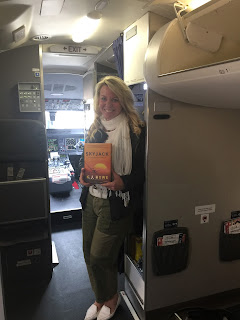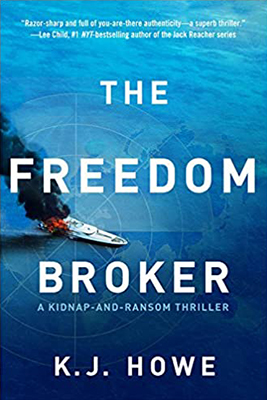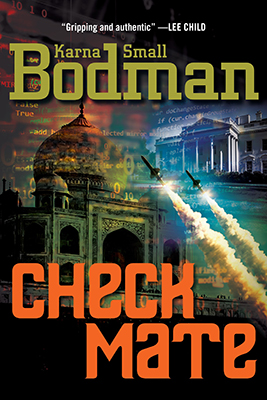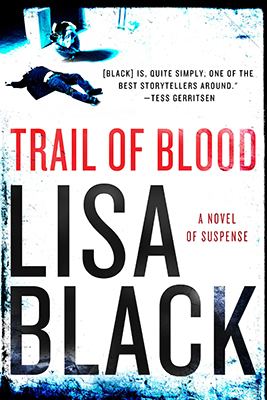 |
| K.J. Howe with SKYJACKED |
Can you imagine taking a flight without x-ray machines, security screenings or TSA officers? Up until the early 1970’s, this was the reality of air travel in America despite a large number of hijackings that took place between 1961 and 1970.
In those “golden days” of skyjacks, most of the hijackings were motivated by money or as a protest against the Vietnam war–and they usually ended peacefully. Many of the hijackers were motivated by sympathy towards the Cuban revolution and simply wanted to land the plane in Cuba and “gift” the aircraft to Fidel Castro.
Sure, there was an economic cost to these events, but there was very little bloodletting in the early days. Airlines and the government were willing to absorb the economic costs of these crimes rather than invest the substantial funds needed to provide effective security.
That’s not to say that the United States government ignored the problem. They created an FAA group to study hijackings, and they invited suggestions from the public on how to battle this crime wave. The public didn’t disappoint, sending in thousands of suggestions, including making all passengers wear boxing gloves so they could not hold a gun, arming flight attendants with tranquilizer darts, building a fake Havana Airport in Florida to fool hijackers into thinking they had reached their destination, and then arresting them when they left the plane–and my personal favorite, installing a trap door in the floor immediately outside of the cockpit so pilots could drop the hijackers 20,000 feet when they tried to takeover the craft.
None of these ideas were ever implemented.
Of course the problem only worsened. Between 1968 and 1972, 130 American aircraft were hijacked and motives were shifting. Monetary demands were skyrocketing upwards and new political motives, many tied to the conflicts in the Middle East were now taking center stage. The destruction of property and the reality of violence were becoming more severe and painful to endure. In 1970, one event changed everything.
On Sept 6, 1970, the Popular Front for the Liberation of Palestine (PFLP) attempted their most ambitious operation to date, trying to hijack four planes from Europe bound for the United States, succeeding in taking control of three of them. On Sept 9, they hijacked yet another plane bound for America. Three of these aircraft were flown to an abandoned British airfield in Jordan named Dawson’s Field, which then became known as Revolution Field. The hostages were removed from the aircraft and the multi-million dollar aircraft were summarily blown up.
The Jordan government responded by declaring martial law, initiating military operations against a number of radical political groups within the large Palestinian refugee population ensconced in Jordan. These events cascaded into the Jordanian Civil War, often referred to as Black September, which included a covert Syrian invasion of Jordanian territory. While the government of Jordan was successful in maintaining control of their country, their relationship with the Palestinian people and the political shape of the Middle East would never be the same again. The fallout included the formation of the notorious terrorist organization known as Black September, a group that carried out many well-known operations, including the massacre of Israeli athletes at the Munich Olympics in 1972.
Over a few weeks, all of the hostages from the hijacked aircraft were released and returned to their home countries in exchange for the release of a number of Palestinian radicals who were being held in prisons in various countries. This ambitious and successful cluster of hijacking operations had changed the shape of the Middle East and world air travel forever.
Eerily, on Sept 11, 1970, President Nixon began an initiative to deal with this new crisis of “air piracy.” His immediate direction included seven steps to increase security, including: appointing the first 100 armed Air Marshals to travel on aircraft, enhancing international co-operation on aircraft security, and transferring x-ray technology available to the military to the civilian sector. While the program began immediately, it was not fully implemented until after a hijacking in 1972, where three convicted felons hijacked a commercial airliner and threatened to fly it into a nuclear facility. By 1973, airports looked very much like they do today.
Since then, with the tragic exception of Sept 11, American passengers and aircraft have rarely been the victims of hijackings. The actions of Nixon and the international community had brought this epidemic of crime and terrorism to an end. While hijackings still do occur with some regularity in other countries, they tend to occur outside of Europe and North America and do not get much coverage in western media. We need to remain vigilant to ensure this safer trend continues.
















































What a fascinating history lesson! While we all may grumble about waiting in security lines, removing our shoes and computers and putting lotions in little plastic bags, it pales in comparison to the tragic consequences of having a terrorist on board. Now, we all should read your new thriller, SKYJACK for an even fuller picture. Thanks for a great post.
Fascinating – and I remember the pre-9-11 days. Funny that the step-up in security has coincided with the shrinking of plane seats. I wonder if this is a coincidence.
I remember these years, too, KJ, with great fondness for the ease and comfort of air travel. Still, every time I go through security today to get on a plane I'm very grateful for the protection, no matter how annoying the process. Thanks for reminding us! Terrific blog!
Fascinating article, Kim. And timely, considering you're on tour with SKYJACK. Curious if any of this played into your book at all?
Going through security has never bothered me at all, though it was rather handy in the days before 9/11 when the Fort Myers airport was about the size of a super Wal-Mart and you could literally stroll in twenty minutes before departure time and be perfectly fine. Now it's much bigger and much more secure, of course.
I do remember the days of getting through security a lot faster with duty weapon and badge, pre-911. Now the process for cops is a lot more sophisticated (thank goodness).
I can remember before security. I liked walking people to the gate, having people come meet me at the gate. Of course, there are a lot things about flying that have improved. Safety, maybe. No smoking! Do you remember when there was a smoking section on the plane?
Not a great marketing strategy. Let's make it extremely difficult to get to the plane, then let's make them uncomfortable while on the plane. I think you may be on to something. The cramped seating makes for more agitated flyers which makes security more necessary.
What is the process for law enforcement? Do they go through the special security screening area that the crew goes through?
I love the idea of a trap door outside the cockpit. Oh, wait, wouldn't that depressurize the plan?
Thanks, Karna! Every time I'm in a security line waiting forever, I think of safety and my blood pressure goes down. 🙂
Sandy, That's an interesting point. Sometimes I wonder if security is compromised via the tighter seating. Larger people would struggle to get out of seats and it would take more time to exit the plane…
Exactly, Gayle. I'm also grateful for security measures….not really up for a trip to Havana this week! 🙂
Robin, yes, I go deep into the nuts and bolts of planes in SKYJACK. I found it fascinating to learn more about how airplanes work…and how to break into a cockpit!
You had me at Fort Myers, Lisa! I love smaller airports. The one at West Palm Beach is also lovely.
I'm very sensitive to smoke, so yes, I totally remember that. Being on the first non-smoking row was terrible as people could blow smoke right at you!
Chris, it would have to be used at certain altitudes…but, heck, it would be interesting!
Much depends on if they're armed. It's sort of a multi-step process that begins long before they even get to the airport.
I enjoyed your presentation at The Book Carnival in Orange. I just finished "Skyjack" and was on the edge of my chair the whole time. Wonderful (and tension-filled) book.